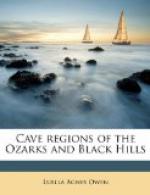Our driver received directions about the road and we started on another drive of seven miles. These directions were “to follow the main road to the forks, and then keep to the Van Buren road and any one could tell us where Captain Greer lives.”
The road was, as before, through the park-like forest, and as before, lay chiefly along the ridge, so that where clearings had been made for farms there were fine views over the distant country, which everywhere was forest-covered hills, of a rich green near at hand but changing with the growth of distance, first to dark, and then to lighter blue.
In these forests were fine young cattle and horses, and uncounted numbers of “razorbacks,” or as they are otherwise called, “wind-splitters.” For the benefit of those who may not be familiar with the names, it might be well to explain that they are the natural heirs of the native wild hog of Missouri and Arkansas. The nephew was greatly amused at seeing many of them with wooden yokes on their long necks, to prevent an easy entrance into fields and gardens by squeezing through the spaces between fence rails. These animals are such swift runners it is said they can safely cross the railroad between trucks of the fast express. Their snouts are so long and thin, it is also claimed that two can drink from a jug at the same time; never having seen it done, however, this is not vouched for, but merely repeated as hearsay.
[Illustration: Wilderness Pinery, Oregon Co. Page 84.]
After a time we stopped to inquire the way of an old man dipping water from a pond by the roadside. He told us he was dipping water to wash the wheat he was sowing in the field just over the fence, and that we reach the forks, then to keep the Van Buren road, pass two houses on the left, a white one on the right, another on the left and then inquire the way—anyone could tell us, and Captain Greer would show us to the Spring, “for he is a mighty accommodating man.”
On we went to the forks where in the point of the Y stood a large tree with a Van Buren sign-board on one side, and in the direction it pointed, we turned, although rather reluctantly, for it looked little used and rocky, while the other was in good condition; but we followed the sign-board and had no misgivings until it began to be realized that a great deal of time was being passed but no houses. The morning had been very chilly, but now the atmosphere was just at that balmy point between warm and cool that makes mere living an unqualified luxury; and added to this we soon found ourselves in a deep canon no less beautiful than the justly celebrated North Cheyenne Canon near Colorado Springs.
There was now no doubt that we were on the wrong road, but such magnificence was unexpected and not to be turned from with indifference.




